NUR251 S2 2019 Assessment 1: Acute Kidney Failure Care Plan Report
VerifiedAdded on 2023/01/05
|20
|4367
|79
Report
AI Summary
This report presents a comprehensive nursing care plan for a 72-year-old male patient, Mr. David Smith, admitted with acute kidney failure, hyperlipidemia, and other comorbidities. The report is structured around three tasks. Task 1 focuses on the initial and ongoing assessments required for a patient with acute kidney failure, including a head-to-toe assessment, medical history, and the use of the PQRST algorithm for pain assessment. Task 2 details a nursing care plan addressing multiple nursing problems. The nursing problems include acute pain, risk of fluid imbalance, risk of infection, anxiety, and impaired skin integrity. For each problem, the plan outlines goals of care, nursing interventions, and the rationale behind each intervention, along with evaluation methods. Task 3 discusses the patient's understanding of his health issues and the importance of patient education. The care plan emphasizes the importance of monitoring vital signs, fluid balance, and skin integrity, and implementing appropriate interventions to address the patient's needs and improve outcomes. The report highlights the significance of ongoing assessment and evaluation to ensure the effectiveness of the nursing interventions.
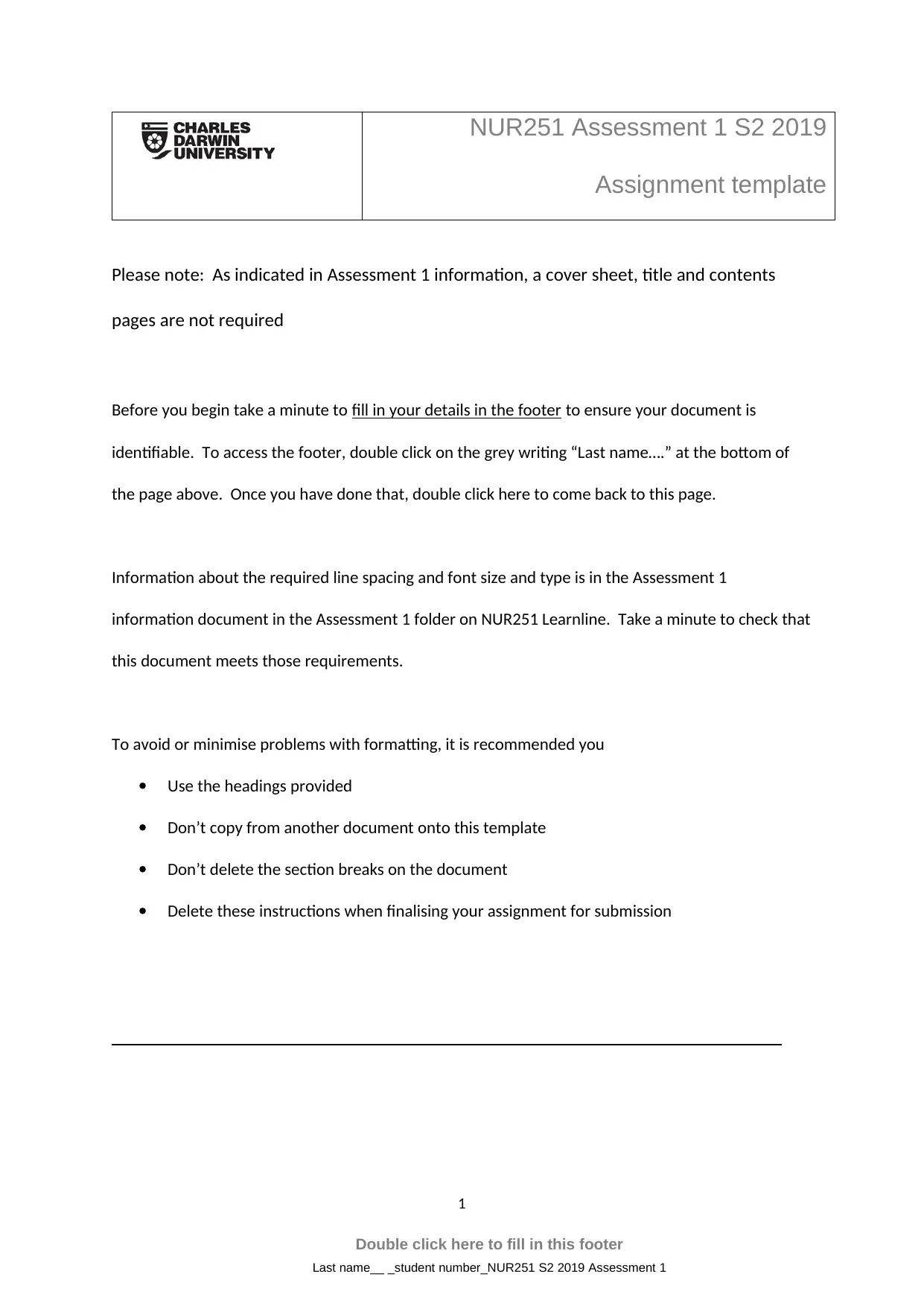
NUR251 Assessment 1 S2 2019
Assignment template
Please note: As indicated in Assessment 1 information, a cover sheet, title and contents
pages are not required
Before you begin take a minute to fill in your details in the footer to ensure your document is
identifiable. To access the footer, double click on the grey writing “Last name….” at the bottom of
the page above. Once you have done that, double click here to come back to this page.
Information about the required line spacing and font size and type is in the Assessment 1
information document in the Assessment 1 folder on NUR251 Learnline. Take a minute to check that
this document meets those requirements.
To avoid or minimise problems with formatting, it is recommended you
Use the headings provided
Don’t copy from another document onto this template
Don’t delete the section breaks on the document
Delete these instructions when finalising your assignment for submission
1
Double click here to fill in this footer
Last name__ _student number_NUR251 S2 2019 Assessment 1
Assignment template
Please note: As indicated in Assessment 1 information, a cover sheet, title and contents
pages are not required
Before you begin take a minute to fill in your details in the footer to ensure your document is
identifiable. To access the footer, double click on the grey writing “Last name….” at the bottom of
the page above. Once you have done that, double click here to come back to this page.
Information about the required line spacing and font size and type is in the Assessment 1
information document in the Assessment 1 folder on NUR251 Learnline. Take a minute to check that
this document meets those requirements.
To avoid or minimise problems with formatting, it is recommended you
Use the headings provided
Don’t copy from another document onto this template
Don’t delete the section breaks on the document
Delete these instructions when finalising your assignment for submission
1
Double click here to fill in this footer
Last name__ _student number_NUR251 S2 2019 Assessment 1
Paraphrase This Document
Need a fresh take? Get an instant paraphrase of this document with our AI Paraphraser

Task 1
The given case study is about a 72 years old man Mr. David Smith. He was admitted
to the hospital because of acute kidney failure having hyperlipidemia, being an ex-smoker,
chronic kidney disease stage 3 and anxiety. At the time of admission, he was having high
fever, decreased output of urine and flank pain. Assessment of the renal failure patient begins
with performing an initial assessment to detect and treat threats to life.
The first assessment that has to be completed is the head to toe assessment, the
medical history and the observations are required to gather the comprehensive baseline data.
With the consent of the patient and maintaining the privacy and the ongoing communication,
the body temperature, the rate of decrease in urine output has to be assessed. The patient was
suffering from pyelonephritis which means he had suffered from infections in the lower
urinary tract, so the infection rate should be assessed (Grams et al., 2016). An observation
chart has to be maintained for noting the progress of David.
The next assessment should be conducted by using the PQRST algorithm. This
assessment has to be conducted to relief the patient from the sufferings of pain as providing
the patient with adequate pain relief will assist in increasing the physical and mental comfort
of the patient (Gordon et al., 2016). These assessments also has to be noted in the observation
chart of the patient.
The next assessment which is to be done is to assess the extremities of oedema. If the
patient is bedridden, the oedema gets accumulated posteriorly in the pre sacral area. The
patient of the given case study has been suffering from oedema in the calves. For assessing
the oedema, the nurse need to compress on the soft tissue of the patients with the thumb and
the indentations must be observed. Another assessment which is required to be done is
checking whether he is suffering from uremic frost on the skin or not. Uremic frost is the
2
Double click here to fill in this footer
Last name__ _student number_NUR251 S2 2019 Assessment 1
The given case study is about a 72 years old man Mr. David Smith. He was admitted
to the hospital because of acute kidney failure having hyperlipidemia, being an ex-smoker,
chronic kidney disease stage 3 and anxiety. At the time of admission, he was having high
fever, decreased output of urine and flank pain. Assessment of the renal failure patient begins
with performing an initial assessment to detect and treat threats to life.
The first assessment that has to be completed is the head to toe assessment, the
medical history and the observations are required to gather the comprehensive baseline data.
With the consent of the patient and maintaining the privacy and the ongoing communication,
the body temperature, the rate of decrease in urine output has to be assessed. The patient was
suffering from pyelonephritis which means he had suffered from infections in the lower
urinary tract, so the infection rate should be assessed (Grams et al., 2016). An observation
chart has to be maintained for noting the progress of David.
The next assessment should be conducted by using the PQRST algorithm. This
assessment has to be conducted to relief the patient from the sufferings of pain as providing
the patient with adequate pain relief will assist in increasing the physical and mental comfort
of the patient (Gordon et al., 2016). These assessments also has to be noted in the observation
chart of the patient.
The next assessment which is to be done is to assess the extremities of oedema. If the
patient is bedridden, the oedema gets accumulated posteriorly in the pre sacral area. The
patient of the given case study has been suffering from oedema in the calves. For assessing
the oedema, the nurse need to compress on the soft tissue of the patients with the thumb and
the indentations must be observed. Another assessment which is required to be done is
checking whether he is suffering from uremic frost on the skin or not. Uremic frost is the
2
Double click here to fill in this footer
Last name__ _student number_NUR251 S2 2019 Assessment 1
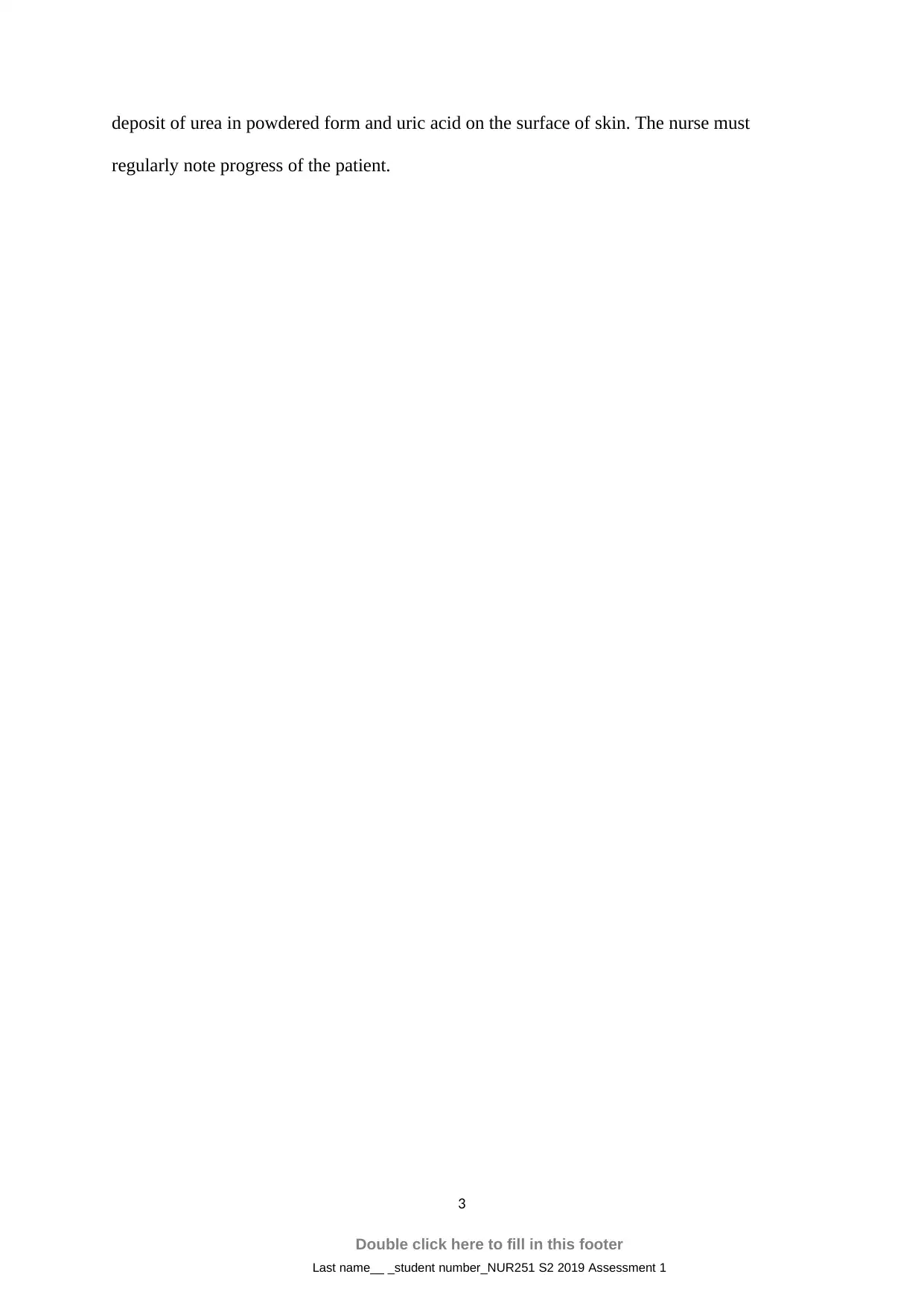
deposit of urea in powdered form and uric acid on the surface of skin. The nurse must
regularly note progress of the patient.
3
Double click here to fill in this footer
Last name__ _student number_NUR251 S2 2019 Assessment 1
regularly note progress of the patient.
3
Double click here to fill in this footer
Last name__ _student number_NUR251 S2 2019 Assessment 1
⊘ This is a preview!⊘
Do you want full access?
Subscribe today to unlock all pages.

Trusted by 1+ million students worldwide
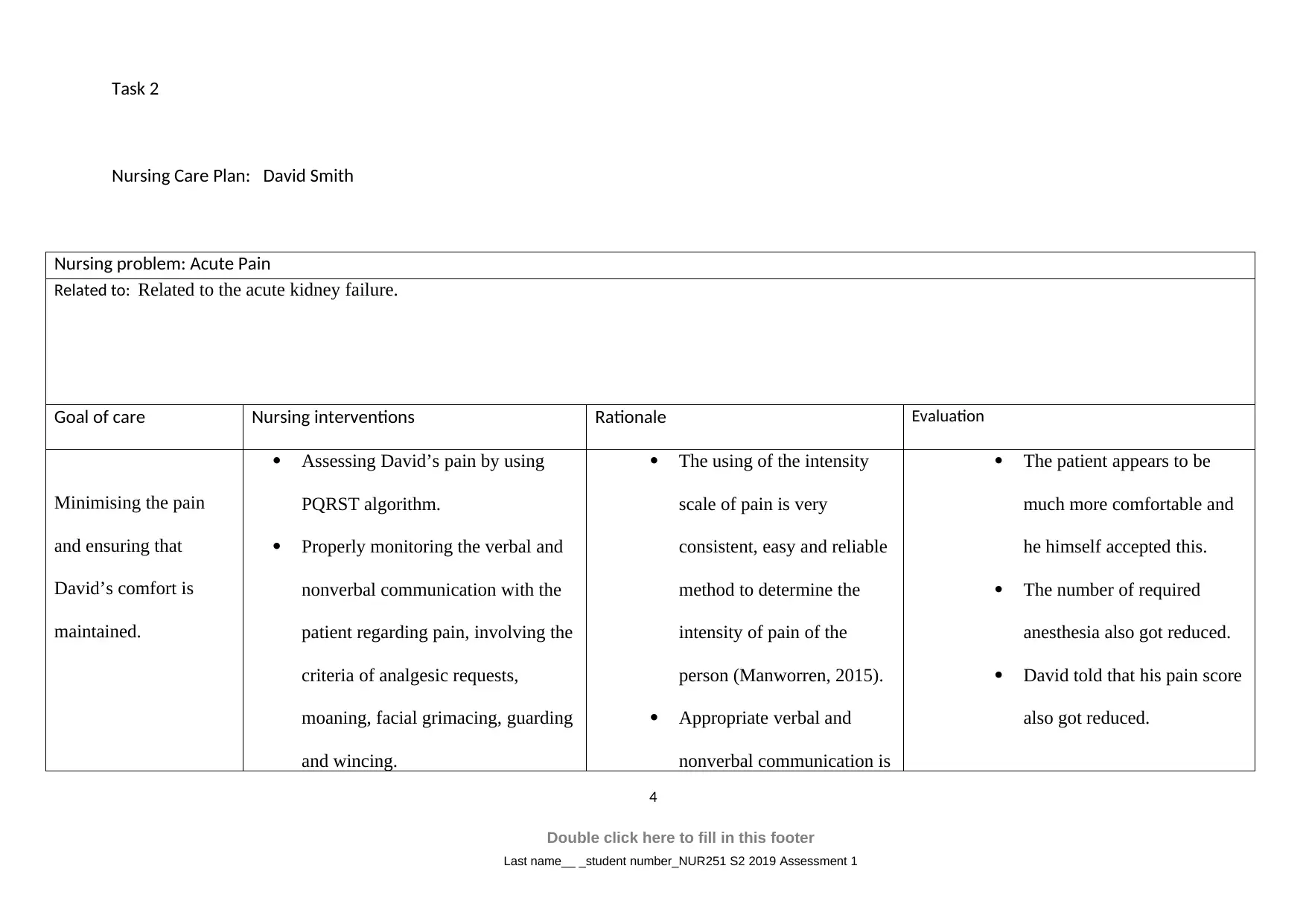
Task 2
Nursing Care Plan: David Smith
Nursing problem: Acute Pain
Related to: Related to the acute kidney failure.
Goal of care Nursing interventions Rationale Evaluation
Minimising the pain
and ensuring that
David’s comfort is
maintained.
Assessing David’s pain by using
PQRST algorithm.
Properly monitoring the verbal and
nonverbal communication with the
patient regarding pain, involving the
criteria of analgesic requests,
moaning, facial grimacing, guarding
and wincing.
The using of the intensity
scale of pain is very
consistent, easy and reliable
method to determine the
intensity of pain of the
person (Manworren, 2015).
Appropriate verbal and
nonverbal communication is
The patient appears to be
much more comfortable and
he himself accepted this.
The number of required
anesthesia also got reduced.
David told that his pain score
also got reduced.
4
Double click here to fill in this footer
Last name__ _student number_NUR251 S2 2019 Assessment 1
Nursing Care Plan: David Smith
Nursing problem: Acute Pain
Related to: Related to the acute kidney failure.
Goal of care Nursing interventions Rationale Evaluation
Minimising the pain
and ensuring that
David’s comfort is
maintained.
Assessing David’s pain by using
PQRST algorithm.
Properly monitoring the verbal and
nonverbal communication with the
patient regarding pain, involving the
criteria of analgesic requests,
moaning, facial grimacing, guarding
and wincing.
The using of the intensity
scale of pain is very
consistent, easy and reliable
method to determine the
intensity of pain of the
person (Manworren, 2015).
Appropriate verbal and
nonverbal communication is
The patient appears to be
much more comfortable and
he himself accepted this.
The number of required
anesthesia also got reduced.
David told that his pain score
also got reduced.
4
Double click here to fill in this footer
Last name__ _student number_NUR251 S2 2019 Assessment 1
Paraphrase This Document
Need a fresh take? Get an instant paraphrase of this document with our AI Paraphraser
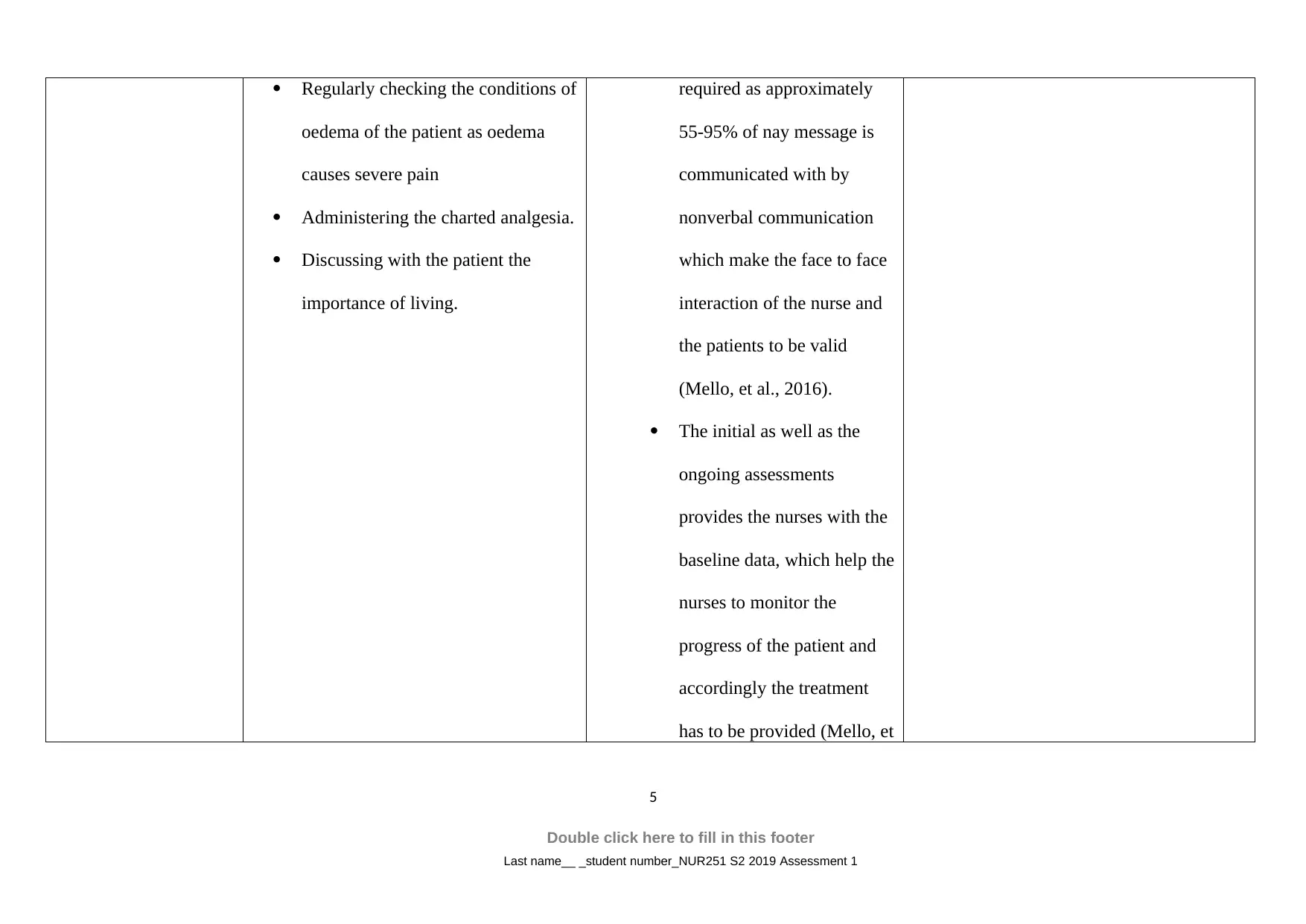
Regularly checking the conditions of
oedema of the patient as oedema
causes severe pain
Administering the charted analgesia.
Discussing with the patient the
importance of living.
required as approximately
55-95% of nay message is
communicated with by
nonverbal communication
which make the face to face
interaction of the nurse and
the patients to be valid
(Mello, et al., 2016).
The initial as well as the
ongoing assessments
provides the nurses with the
baseline data, which help the
nurses to monitor the
progress of the patient and
accordingly the treatment
has to be provided (Mello, et
5
Double click here to fill in this footer
Last name__ _student number_NUR251 S2 2019 Assessment 1
oedema of the patient as oedema
causes severe pain
Administering the charted analgesia.
Discussing with the patient the
importance of living.
required as approximately
55-95% of nay message is
communicated with by
nonverbal communication
which make the face to face
interaction of the nurse and
the patients to be valid
(Mello, et al., 2016).
The initial as well as the
ongoing assessments
provides the nurses with the
baseline data, which help the
nurses to monitor the
progress of the patient and
accordingly the treatment
has to be provided (Mello, et
5
Double click here to fill in this footer
Last name__ _student number_NUR251 S2 2019 Assessment 1
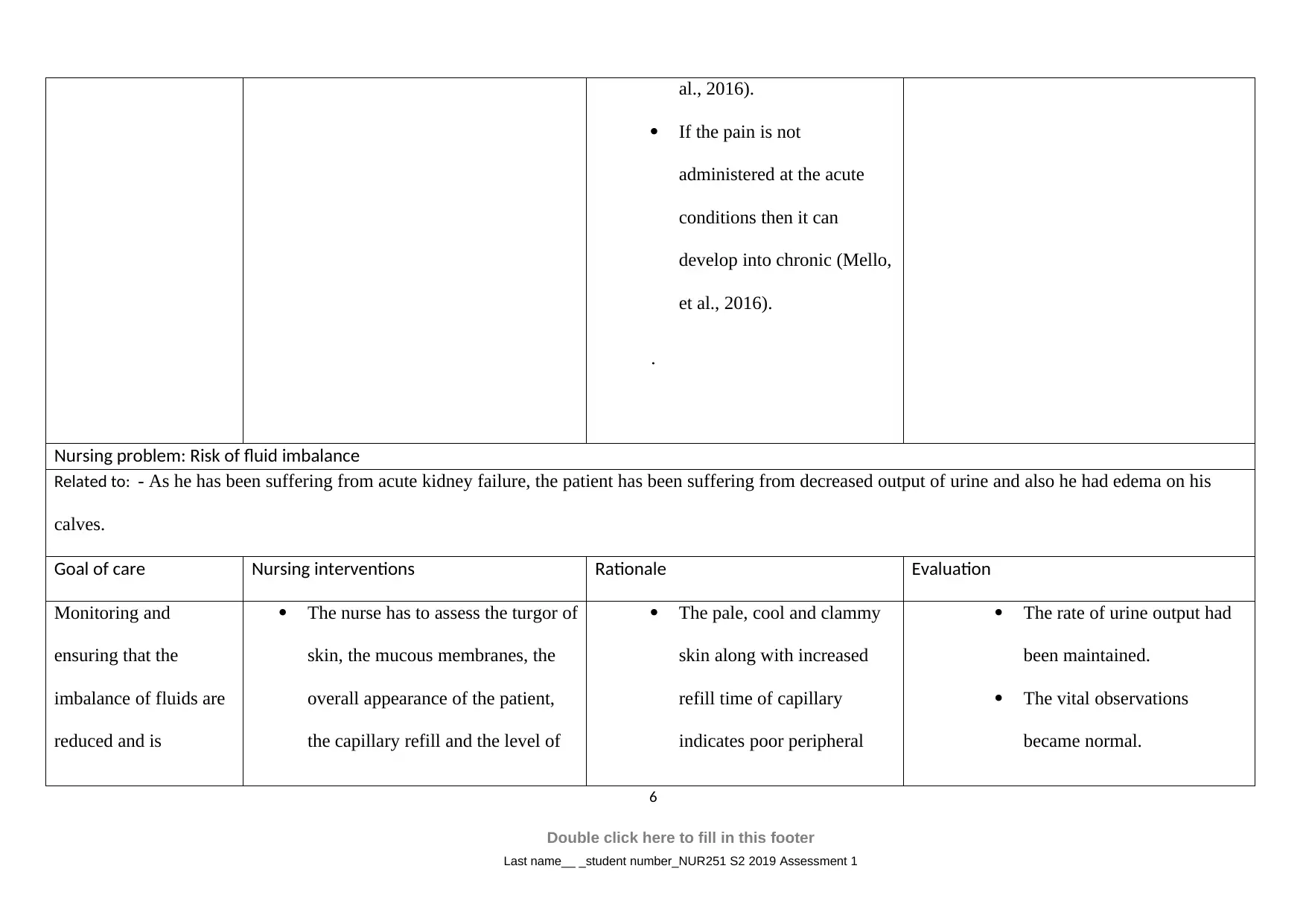
al., 2016).
If the pain is not
administered at the acute
conditions then it can
develop into chronic (Mello,
et al., 2016).
.
Nursing problem: Risk of fluid imbalance
Related to: - As he has been suffering from acute kidney failure, the patient has been suffering from decreased output of urine and also he had edema on his
calves.
Goal of care Nursing interventions Rationale Evaluation
Monitoring and
ensuring that the
imbalance of fluids are
reduced and is
The nurse has to assess the turgor of
skin, the mucous membranes, the
overall appearance of the patient,
the capillary refill and the level of
The pale, cool and clammy
skin along with increased
refill time of capillary
indicates poor peripheral
The rate of urine output had
been maintained.
The vital observations
became normal.
6
Double click here to fill in this footer
Last name__ _student number_NUR251 S2 2019 Assessment 1
If the pain is not
administered at the acute
conditions then it can
develop into chronic (Mello,
et al., 2016).
.
Nursing problem: Risk of fluid imbalance
Related to: - As he has been suffering from acute kidney failure, the patient has been suffering from decreased output of urine and also he had edema on his
calves.
Goal of care Nursing interventions Rationale Evaluation
Monitoring and
ensuring that the
imbalance of fluids are
reduced and is
The nurse has to assess the turgor of
skin, the mucous membranes, the
overall appearance of the patient,
the capillary refill and the level of
The pale, cool and clammy
skin along with increased
refill time of capillary
indicates poor peripheral
The rate of urine output had
been maintained.
The vital observations
became normal.
6
Double click here to fill in this footer
Last name__ _student number_NUR251 S2 2019 Assessment 1
⊘ This is a preview!⊘
Do you want full access?
Subscribe today to unlock all pages.

Trusted by 1+ million students worldwide

maintained at normal thirst of the patient. The nurse at the
same time must ensure that a
regular communication has been
maintained for assessing the level
of consciousness and level of
orientation.
The nurse must assess the rate of
heat beat, the blood pressure, and
respiratory rate. Apart from these
the nurse must also daily check the
weight of the patient for identifying
the signs of fluid imbalance and
oedema, a person weighs more if he
has oedema.
Properly monitoring the input and
the output of fluids through
maintaining a balance chart of the
perfusion (Cavalcante et al.,
2015).
The heart beat and blood
pressure should be checked
whether he has hypovolemia
or hypertension (Asfour,
2016).
The observations of the fluid
balance are required to
determine hydration and it
also help in knowing the
signs which warns for
deterioration (Asfour, 2016).
The proper hygiene helps in
preventing from disease or
7
Double click here to fill in this footer
Last name__ _student number_NUR251 S2 2019 Assessment 1
same time must ensure that a
regular communication has been
maintained for assessing the level
of consciousness and level of
orientation.
The nurse must assess the rate of
heat beat, the blood pressure, and
respiratory rate. Apart from these
the nurse must also daily check the
weight of the patient for identifying
the signs of fluid imbalance and
oedema, a person weighs more if he
has oedema.
Properly monitoring the input and
the output of fluids through
maintaining a balance chart of the
perfusion (Cavalcante et al.,
2015).
The heart beat and blood
pressure should be checked
whether he has hypovolemia
or hypertension (Asfour,
2016).
The observations of the fluid
balance are required to
determine hydration and it
also help in knowing the
signs which warns for
deterioration (Asfour, 2016).
The proper hygiene helps in
preventing from disease or
7
Double click here to fill in this footer
Last name__ _student number_NUR251 S2 2019 Assessment 1
Paraphrase This Document
Need a fresh take? Get an instant paraphrase of this document with our AI Paraphraser
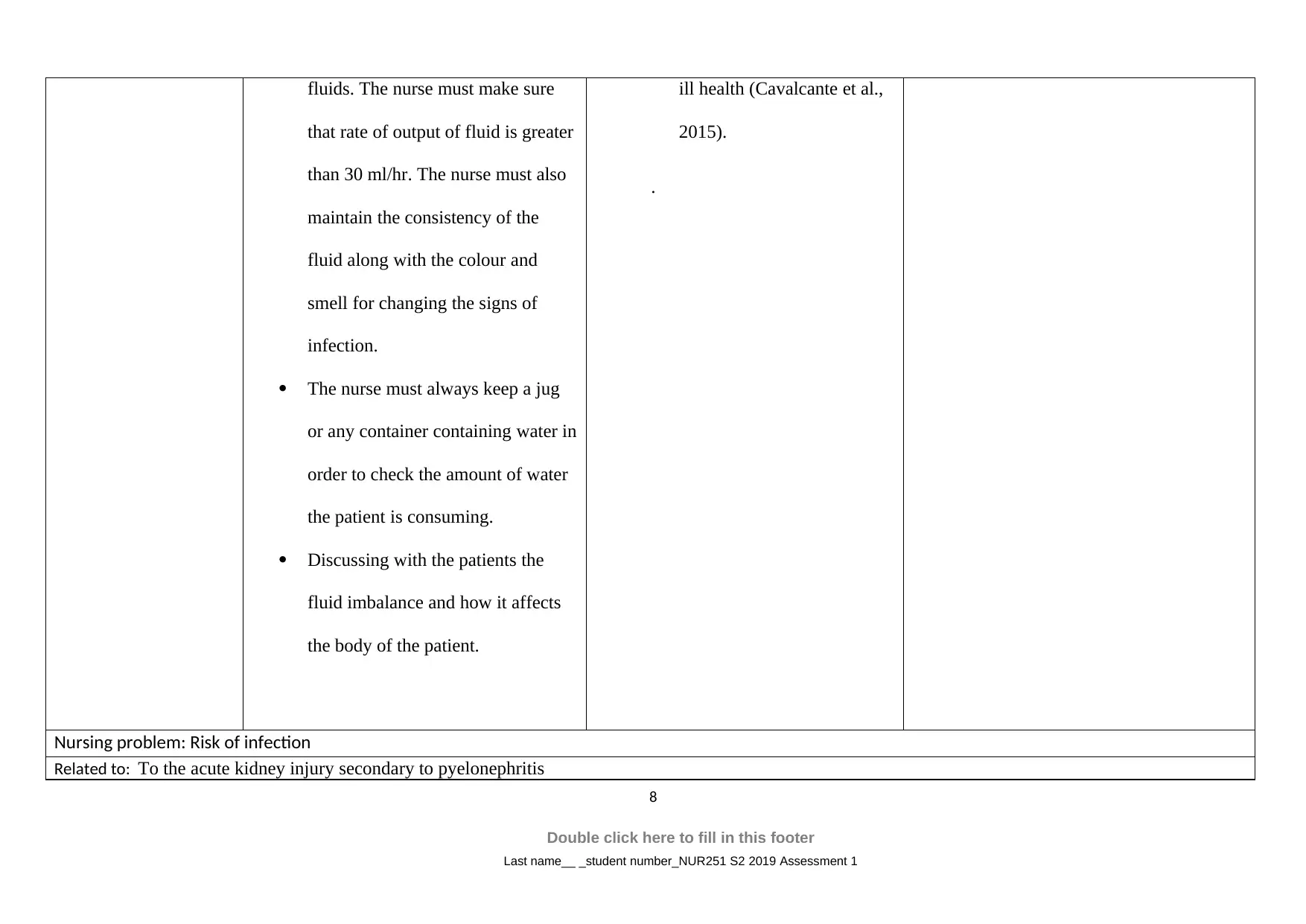
fluids. The nurse must make sure
that rate of output of fluid is greater
than 30 ml/hr. The nurse must also
maintain the consistency of the
fluid along with the colour and
smell for changing the signs of
infection.
The nurse must always keep a jug
or any container containing water in
order to check the amount of water
the patient is consuming.
Discussing with the patients the
fluid imbalance and how it affects
the body of the patient.
ill health (Cavalcante et al.,
2015).
.
Nursing problem: Risk of infection
Related to: To the acute kidney injury secondary to pyelonephritis
8
Double click here to fill in this footer
Last name__ _student number_NUR251 S2 2019 Assessment 1
that rate of output of fluid is greater
than 30 ml/hr. The nurse must also
maintain the consistency of the
fluid along with the colour and
smell for changing the signs of
infection.
The nurse must always keep a jug
or any container containing water in
order to check the amount of water
the patient is consuming.
Discussing with the patients the
fluid imbalance and how it affects
the body of the patient.
ill health (Cavalcante et al.,
2015).
.
Nursing problem: Risk of infection
Related to: To the acute kidney injury secondary to pyelonephritis
8
Double click here to fill in this footer
Last name__ _student number_NUR251 S2 2019 Assessment 1
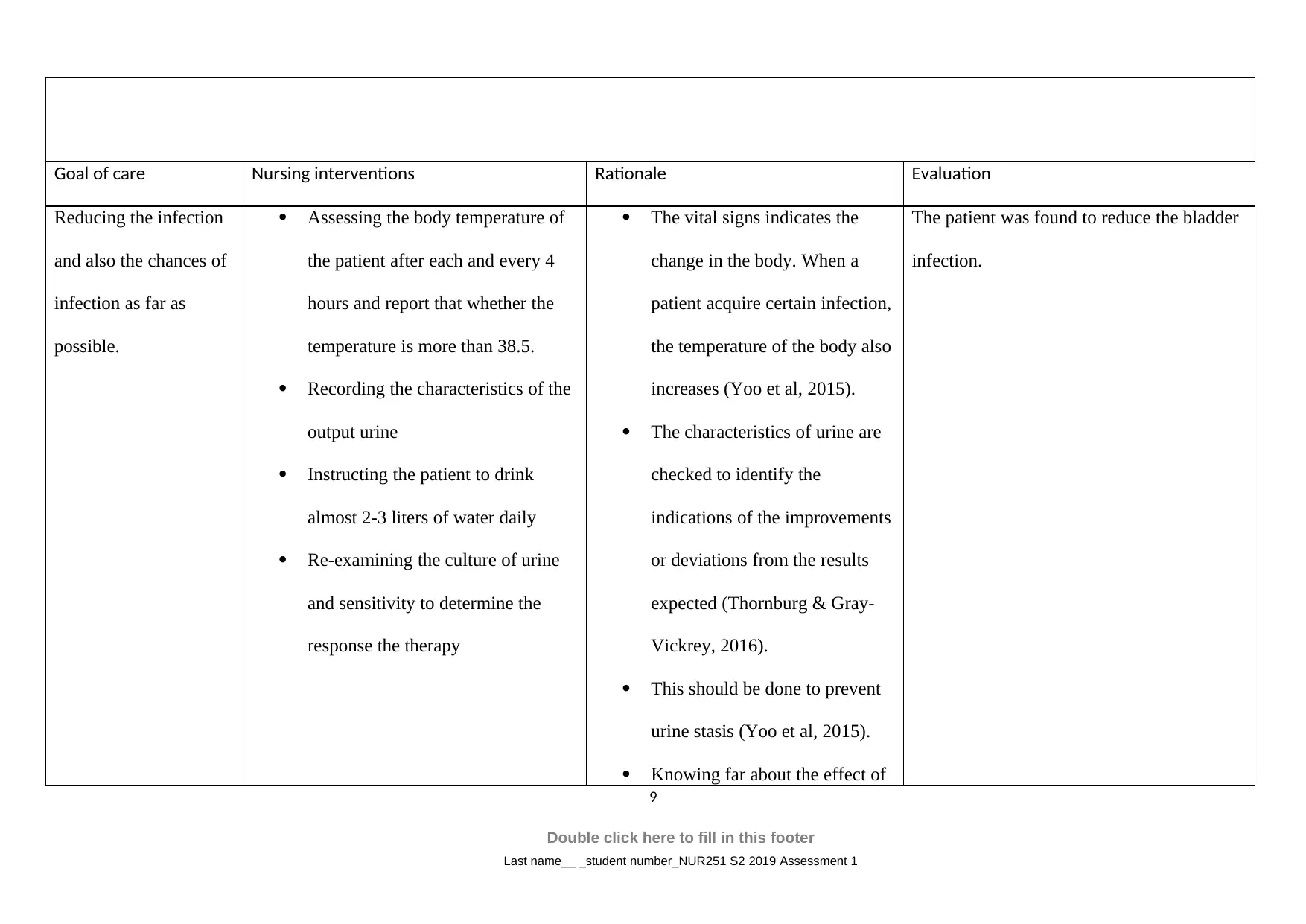
Goal of care Nursing interventions Rationale Evaluation
Reducing the infection
and also the chances of
infection as far as
possible.
Assessing the body temperature of
the patient after each and every 4
hours and report that whether the
temperature is more than 38.5.
Recording the characteristics of the
output urine
Instructing the patient to drink
almost 2-3 liters of water daily
Re-examining the culture of urine
and sensitivity to determine the
response the therapy
The vital signs indicates the
change in the body. When a
patient acquire certain infection,
the temperature of the body also
increases (Yoo et al, 2015).
The characteristics of urine are
checked to identify the
indications of the improvements
or deviations from the results
expected (Thornburg & Gray-
Vickrey, 2016).
This should be done to prevent
urine stasis (Yoo et al, 2015).
Knowing far about the effect of
The patient was found to reduce the bladder
infection.
9
Double click here to fill in this footer
Last name__ _student number_NUR251 S2 2019 Assessment 1
Reducing the infection
and also the chances of
infection as far as
possible.
Assessing the body temperature of
the patient after each and every 4
hours and report that whether the
temperature is more than 38.5.
Recording the characteristics of the
output urine
Instructing the patient to drink
almost 2-3 liters of water daily
Re-examining the culture of urine
and sensitivity to determine the
response the therapy
The vital signs indicates the
change in the body. When a
patient acquire certain infection,
the temperature of the body also
increases (Yoo et al, 2015).
The characteristics of urine are
checked to identify the
indications of the improvements
or deviations from the results
expected (Thornburg & Gray-
Vickrey, 2016).
This should be done to prevent
urine stasis (Yoo et al, 2015).
Knowing far about the effect of
The patient was found to reduce the bladder
infection.
9
Double click here to fill in this footer
Last name__ _student number_NUR251 S2 2019 Assessment 1
⊘ This is a preview!⊘
Do you want full access?
Subscribe today to unlock all pages.

Trusted by 1+ million students worldwide
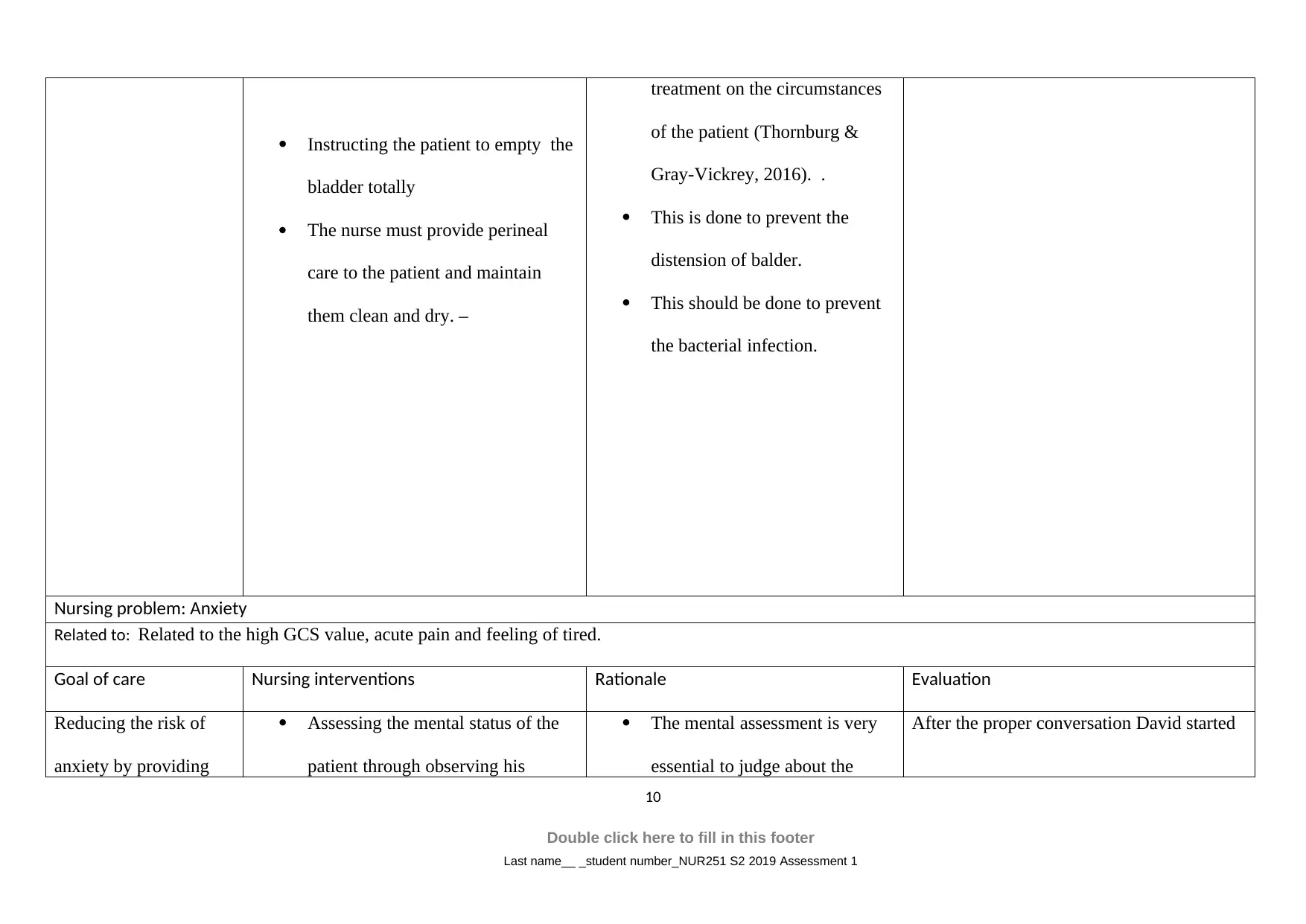
Instructing the patient to empty the
bladder totally
The nurse must provide perineal
care to the patient and maintain
them clean and dry. –
treatment on the circumstances
of the patient (Thornburg &
Gray-Vickrey, 2016). .
This is done to prevent the
distension of balder.
This should be done to prevent
the bacterial infection.
Nursing problem: Anxiety
Related to: Related to the high GCS value, acute pain and feeling of tired.
Goal of care Nursing interventions Rationale Evaluation
Reducing the risk of
anxiety by providing
Assessing the mental status of the
patient through observing his
The mental assessment is very
essential to judge about the
After the proper conversation David started
10
Double click here to fill in this footer
Last name__ _student number_NUR251 S2 2019 Assessment 1
bladder totally
The nurse must provide perineal
care to the patient and maintain
them clean and dry. –
treatment on the circumstances
of the patient (Thornburg &
Gray-Vickrey, 2016). .
This is done to prevent the
distension of balder.
This should be done to prevent
the bacterial infection.
Nursing problem: Anxiety
Related to: Related to the high GCS value, acute pain and feeling of tired.
Goal of care Nursing interventions Rationale Evaluation
Reducing the risk of
anxiety by providing
Assessing the mental status of the
patient through observing his
The mental assessment is very
essential to judge about the
After the proper conversation David started
10
Double click here to fill in this footer
Last name__ _student number_NUR251 S2 2019 Assessment 1
Paraphrase This Document
Need a fresh take? Get an instant paraphrase of this document with our AI Paraphraser
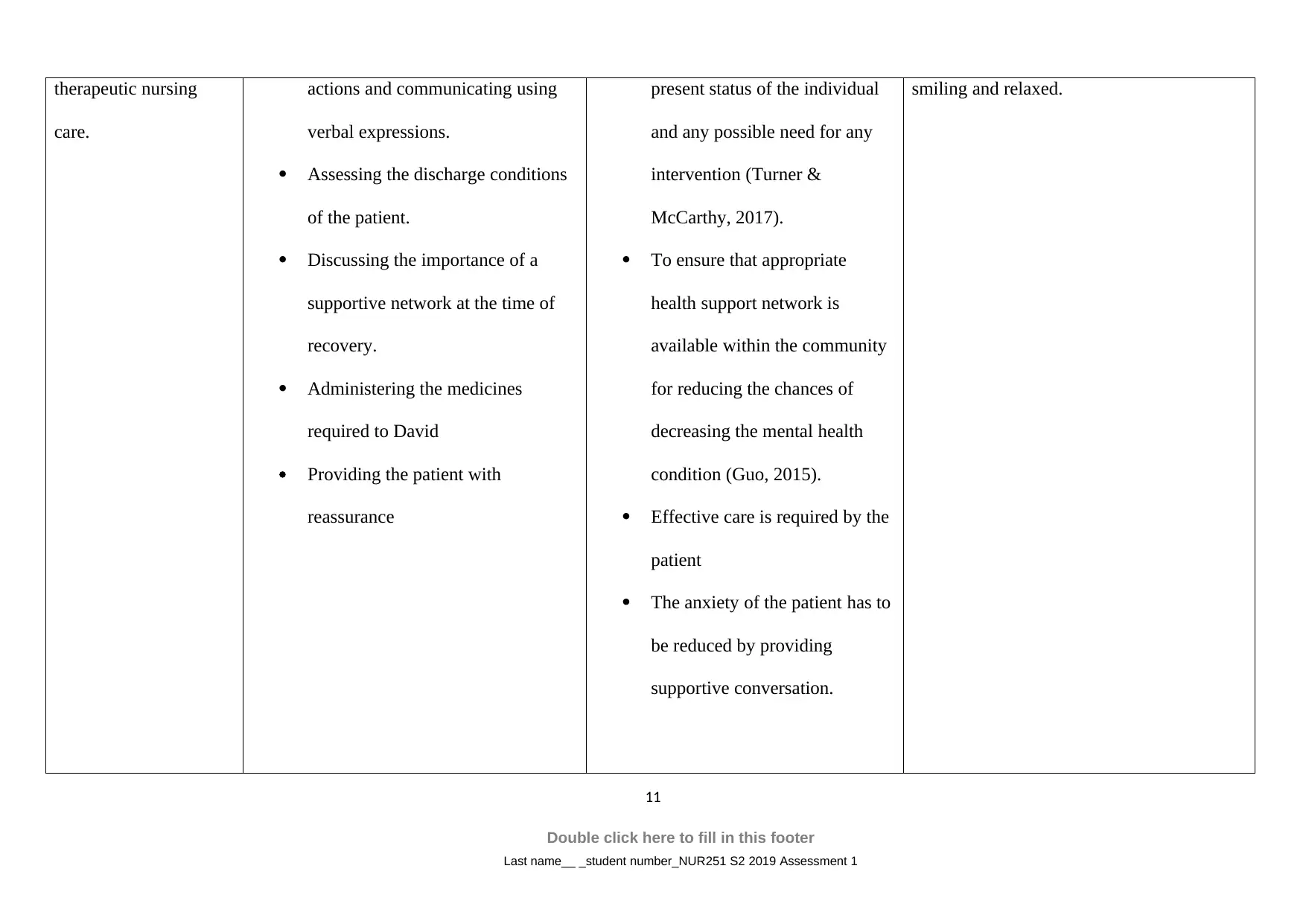
therapeutic nursing
care.
actions and communicating using
verbal expressions.
Assessing the discharge conditions
of the patient.
Discussing the importance of a
supportive network at the time of
recovery.
Administering the medicines
required to David
Providing the patient with
reassurance
present status of the individual
and any possible need for any
intervention (Turner &
McCarthy, 2017).
To ensure that appropriate
health support network is
available within the community
for reducing the chances of
decreasing the mental health
condition (Guo, 2015).
Effective care is required by the
patient
The anxiety of the patient has to
be reduced by providing
supportive conversation.
smiling and relaxed.
11
Double click here to fill in this footer
Last name__ _student number_NUR251 S2 2019 Assessment 1
care.
actions and communicating using
verbal expressions.
Assessing the discharge conditions
of the patient.
Discussing the importance of a
supportive network at the time of
recovery.
Administering the medicines
required to David
Providing the patient with
reassurance
present status of the individual
and any possible need for any
intervention (Turner &
McCarthy, 2017).
To ensure that appropriate
health support network is
available within the community
for reducing the chances of
decreasing the mental health
condition (Guo, 2015).
Effective care is required by the
patient
The anxiety of the patient has to
be reduced by providing
supportive conversation.
smiling and relaxed.
11
Double click here to fill in this footer
Last name__ _student number_NUR251 S2 2019 Assessment 1
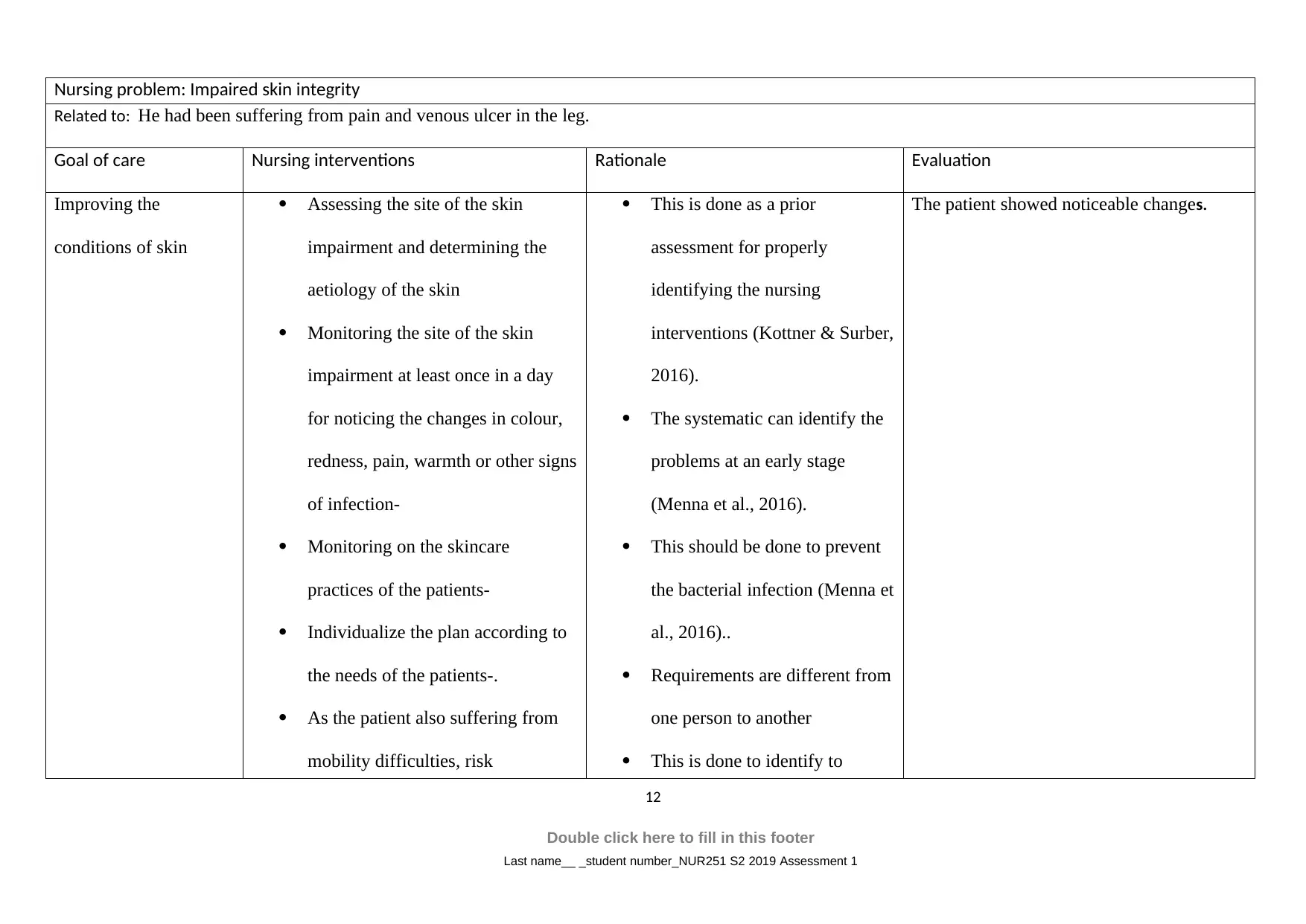
Nursing problem: Impaired skin integrity
Related to: He had been suffering from pain and venous ulcer in the leg.
Goal of care Nursing interventions Rationale Evaluation
Improving the
conditions of skin
Assessing the site of the skin
impairment and determining the
aetiology of the skin
Monitoring the site of the skin
impairment at least once in a day
for noticing the changes in colour,
redness, pain, warmth or other signs
of infection-
Monitoring on the skincare
practices of the patients-
Individualize the plan according to
the needs of the patients-.
As the patient also suffering from
mobility difficulties, risk
This is done as a prior
assessment for properly
identifying the nursing
interventions (Kottner & Surber,
2016).
The systematic can identify the
problems at an early stage
(Menna et al., 2016).
This should be done to prevent
the bacterial infection (Menna et
al., 2016)..
Requirements are different from
one person to another
This is done to identify to
The patient showed noticeable changes.
12
Double click here to fill in this footer
Last name__ _student number_NUR251 S2 2019 Assessment 1
Related to: He had been suffering from pain and venous ulcer in the leg.
Goal of care Nursing interventions Rationale Evaluation
Improving the
conditions of skin
Assessing the site of the skin
impairment and determining the
aetiology of the skin
Monitoring the site of the skin
impairment at least once in a day
for noticing the changes in colour,
redness, pain, warmth or other signs
of infection-
Monitoring on the skincare
practices of the patients-
Individualize the plan according to
the needs of the patients-.
As the patient also suffering from
mobility difficulties, risk
This is done as a prior
assessment for properly
identifying the nursing
interventions (Kottner & Surber,
2016).
The systematic can identify the
problems at an early stage
(Menna et al., 2016).
This should be done to prevent
the bacterial infection (Menna et
al., 2016)..
Requirements are different from
one person to another
This is done to identify to
The patient showed noticeable changes.
12
Double click here to fill in this footer
Last name__ _student number_NUR251 S2 2019 Assessment 1
⊘ This is a preview!⊘
Do you want full access?
Subscribe today to unlock all pages.

Trusted by 1+ million students worldwide
1 out of 20
Related Documents
Your All-in-One AI-Powered Toolkit for Academic Success.
+13062052269
info@desklib.com
Available 24*7 on WhatsApp / Email
![[object Object]](/_next/static/media/star-bottom.7253800d.svg)
Unlock your academic potential
Copyright © 2020–2025 A2Z Services. All Rights Reserved. Developed and managed by ZUCOL.




